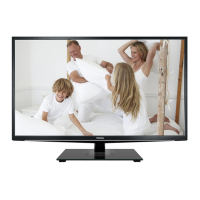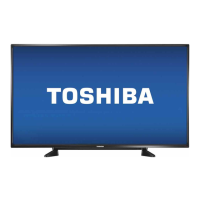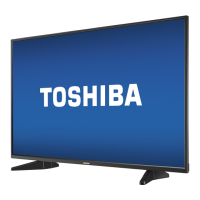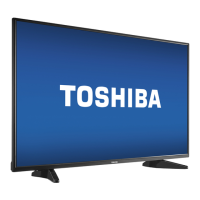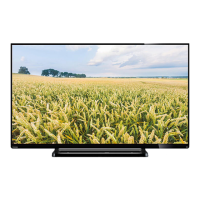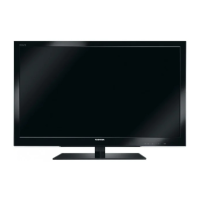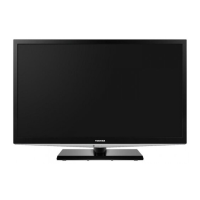Do you have a question about the Toshiba 46G300U and is the answer not in the manual?
Section to record model and serial numbers for future reference.
General safety warnings regarding fire and electric shock.
Guidance on safe placement of displays and furniture.
Instructions and precautions for installation, care, and servicing.
Recommendations for maintaining the TV for optimal performance and safety.
Guidelines for selecting a safe and suitable location for the TV.
Step-by-step instructions for detaching the TV's stand.
Technical limitations of LCD technology, not indicating malfunction.
Highlights the key features and technologies of the new Toshiba TV.
A comprehensive guide to the initial setup and usage of the TV.
Identifies and explains the TV's front and side panel buttons and ports.
Identifies and describes the TV's rear panel input and output terminals.
Descriptions of various video and audio cables used for connections.
Instructions for connecting VCR, antenna, and camcorder devices.
Detailed connection guide for multiple external devices.
Steps for connecting devices using HDMI or DVI interfaces.
How to connect and control compatible devices via HDMI.
Guide for connecting external digital audio equipment.
Instructions for connecting a PC to the TV.
Steps to connect the TV to a home network for file sharing.
Diagrams and instructions for establishing a home network connection.
Initial setup and overview of the remote control's capabilities.
Instructions for inserting batteries into the remote control.
Information on optimal operating distance and angle for the remote.
Identification and explanation of remote control buttons.
Programming the remote to operate external devices.
A reference table detailing remote button functions for different modes.
Detailed steps for programming the remote for other devices.
A list of codes for controlling various brands of devices.
Continuation of the list of remote control codes.
An overview of the TV's main menu structure and options.
Explains the structure of the setup and installation menus.
Instructions on how to move through and select menu items.
Guided process for the first-time setup of the TV.
Option to enable or disable the Toshiba logo indicator light.
Setting the correct input source for antenna or cable.
Instructions for storing available channels in the TV's memory.
How to scan and store all available channels automatically.
Method to skip specific channels, preventing their selection.
Assigning custom names or logos to channels for easier identification.
Configuring audio settings for HDMI inputs.
Checking the signal strength for digital channels.
Adjusting the TV's time zone for accurate status information.
Instructions to restore the TV to its original factory settings.
How to switch between different connected video devices.
Customizing names for input sources for clarity.
Methods for selecting channels using the Channel Browser and Favorites.
Managing and accessing a list of favorite channels.
Explains the components and lists within the Channel Browser interface.
Managing the list of recently viewed channels/inputs.
Configuring how analog and digital channels are tuned.
Manual methods for tuning to desired channels.
Adjusting the display aspect ratio for optimal viewing.
Adjusting picture size via the TV's menu system.
Adjusting letterbox picture display for TheaterWide modes.
Enabling automatic adjustment of picture size based on input signal.
Freezing the current video image.
Choosing from preset picture quality modes.
Fine-tuning picture settings like contrast, brightness, and color.
Enabling and configuring closed caption display.
Customizing the appearance of digital closed captions.
Overview of audio adjustment options, including muting.
Choosing between stereo, mono, or SAP audio modes.
Fine-tuning bass, treble, and balance for audio output.
Configuring the format for digital audio output.
Accessing features like parental controls, input locks, and panel locks.
Steps for entering or setting the security PIN code.
Using V-Chip to block programs based on ratings.
Restricting access to specific TV channels using the PIN.
Temporarily bypassing program lock mode.
Locking specific video input sources to prevent unauthorized viewing.
Disabling the physical buttons on the TV.
Adjusting image settings when a PC is connected.
Configuring audio output for PC input.
Accessing and playing media files from USB devices.
Displaying photos in Multi View, Single View, or Slideshow modes.
Listening to music files from a connected device.
Using the Media Player to view photos while music plays.
Accessing digital content stored on a DLNA server.
Playing video files from a connected device.
Configuring network settings for LAN connection.
Configuring network connectivity.
Setting the TV to turn off automatically after a specified time.
Controlling connected REGZA-LINK compatible devices.
Using the TV remote to control an audio receiver's volume.
Viewing current TV input, channel, and signal status.
Automatically adjusting picture contrast for better appearance.
Adjusting the picture's black levels.
Adjusting the overall color tone of the picture.
Optimizing picture settings for viewing movies.
Reducing motion blur for smoother video playback.
Reducing visible interference in the TV picture.
Reducing interference caused by MPEG compression.
Minimizing input lag for video games.
Applying positional 3D sound effects.
Common issues and basic solutions before contacting service.
Troubleshooting specific display-related issues.
Troubleshooting audio-related issues.
Troubleshooting issues with the remote control.
Troubleshooting difficulties with channel reception or tuning.
Troubleshooting network connectivity issues.
Specific troubleshooting steps for automatic network setup failures.
Troubleshooting issues encountered while using the Media Player.
Technical details and dimensions of the TV model.
Lists compatible signal formats for PC and HDMI inputs.
Details of the warranty coverage for LCD TVs in the US.
Details of the warranty coverage for TVs in Canada.
Legal disclaimers regarding warranty and liability.
Process for resolving disputes related to the warranty.
Instructions on how to get warranty service for the product.
Contact and address details for Toshiba America.
Steps for attaching the TV's pedestal stand.
Basic steps for receiving an HDTV signal.
Connecting the TV to a High-Definition signal source.
Phone numbers and website for customer support and service inquiries.
Form for registering the product to receive information and benefits.
Addresses for sending correspondence and products to Toshiba.
Details and purpose of the product registration card.
| Screen Size | 46 inches |
|---|---|
| Resolution | 1920 x 1080 |
| Display Type | LCD |
| Backlight Type | CCFL |
| HDMI Ports | 3 |
| USB Ports | 1 |
| Audio Output | 10W x 2 |
| Weight | 40.0 lbs |
| Refresh Rate | 120Hz |
| Contrast Ratio | 3000:1 |
| Brightness | 500 cd/m² |
| Viewing Angle | 178° |
| Response Time | 8 ms |
| Inputs | HDMI, Component, Composite |

